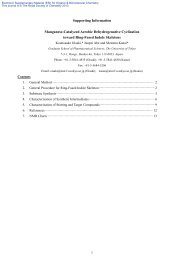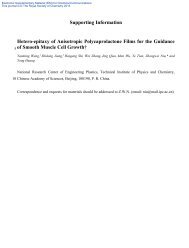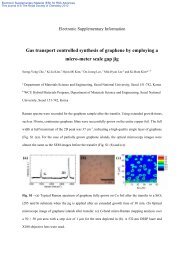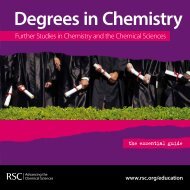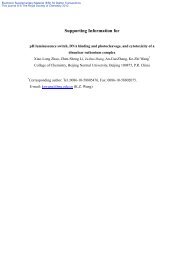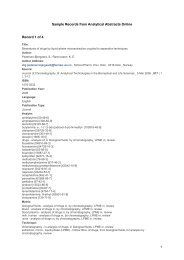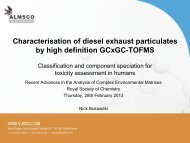Atom and molecule: upper secondary school French students ...
Atom and molecule: upper secondary school French students ...
Atom and molecule: upper secondary school French students ...
You also want an ePaper? Increase the reach of your titles
YUMPU automatically turns print PDFs into web optimized ePapers that Google loves.
A. Cokelez <strong>and</strong> A. Dumon 128<br />
The analysis of the <strong>students</strong>' answers leads to various kinds of diagrams <strong>and</strong> levels of<br />
description, as happened for the atom. Key words appearing in the descriptions are presented<br />
in Table 2 (Appendix).<br />
Different kinds of diagram:<br />
D.0: Erroneous answer or no answer.<br />
D.1: Space-filling model.<br />
D.2: Ball <strong>and</strong> stick model.<br />
D.3: Lewis structural formula model.<br />
D.4: Lewis formula model.<br />
Examples of such diagrams are given in figure 5.<br />
Figure 5: examples of diagrams of the water <strong>molecule</strong><br />
2<br />
1<br />
Space-filling model<br />
Ball <strong>and</strong> stick model<br />
Lewis structural formula<br />
Lewis formula<br />
Levels of description:<br />
L.0: Erroneous description or no answer.<br />
L.1: Water <strong>molecule</strong> is made of two atoms of hydrogen <strong>and</strong> one atom of oxygen.<br />
L.2: Water <strong>molecule</strong> is made of two atoms of hydrogen linked to one atom of oxygen.<br />
L.3: Water <strong>molecule</strong> is made of two atoms of hydrogen linked to one atom of oxygen by a<br />
covalent bond (or simple bond).<br />
L.4: Water <strong>molecule</strong> is made of two atoms of hydrogen linked to one atom of oxygen by a<br />
covalent bond composed of two electrons (or linked electron pair).<br />
L.5: Water <strong>molecule</strong> is made of two atoms of hydrogen linked to one atom of oxygen by a<br />
covalent bond. Each atom contributes one electron to make the bond.<br />
Level 1 is required at the end of grade 9, level 3 is the minimum judged acceptable at the<br />
end of grade 10 <strong>and</strong> level 5 corresponds to the level of formulation in that class.<br />
Analysis of results<br />
Diagram of the water <strong>molecule</strong><br />
The percentage of total answers to this second question is higher than that to the<br />
questions on the atom. Students seem more familiar with the water <strong>molecule</strong> than with the<br />
atom. Yet it is puzzling to note that the difference between these two percentages is higher<br />
for grade 12 <strong>students</strong> (-16%) than for grade 10 (-13%) although the description of water<br />
<strong>molecule</strong> is taught in grade 10 <strong>and</strong> 11 curricula.<br />
As Pereira <strong>and</strong> Pestana (1991) <strong>and</strong> Harrison <strong>and</strong> Treagust (1996) showed, Figure 6 shows<br />
an evolution in the drawing of diagrams along Upper Secondary School. When entering grade<br />
10, the majority of <strong>students</strong> (68%) choose the model that was introduced at Lower Secondary<br />
level: the space-filling model. In grades 11 <strong>and</strong> 12, they mainly rely on Lewis formula model,<br />
which was studied in grade 10 (37%). In grade10, ball <strong>and</strong> stick models of <strong>molecule</strong> are also<br />
Chemistry Education Research <strong>and</strong> Practice, 2005, 6 (3), 119-135<br />
This journal is © The Royal Society of Chemistry





